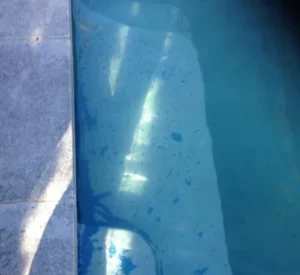High pH levels will cause calcium carbonate in the water to precipitate or bond to the fiberglass surface. When this happens, it often leaves a white gritty layer that looks much worse when dry. As the picture shows, this white layer becomes very noticeable when the pool water drops below its normal level.
To help prevent calcium in fiberglass pools, regularly test the pH and calcium hardness levels of your pool water. Remember, high calcium (above 250ppm) often occurs for two reasons. First, if you add too much calcium chloride (calcium increaser) to the water it will often lead to calcium formation. Secondly, calcium-based granular chlorine will increase the calcium hardness levels in your pool. Remember, if your calcium levels are rising for no reason, then it is likely that granular chlorine (calcium hypochlorite) is the cause. Finally, if your tap water is hard (high in calcium) then this can also contribute to the issue. IF it is your tap water, you’ll see white film on your shower walls, inside your toilet reservoir, and even dish washer with dishes having white spots.
Check that your pool shop is aware that your pool is fiberglass and not concrete and that Manufacturer recommends 250PPM calcium hardness max. You can try using Pool Magnet Plus by Biogard or another product made to remove calcium hardness to lower it. You’ll still have calcium carbonate stuck in the gelcoat pores (Gelcoat is porous, not waterproof, it’s the Resin in Fiberglass that is waterproof) and will take several scrubbings and a chelating agent like Pool Magnet Plus which you then vacuum up once it clumps.
- Test Water Hardness. If above 250, you will need to drain your pool 10% and refill with fresh water. Continue doing this until your calcium hardness between 180-250.
- Get your PH level around 7.5 (again high PH + calcium = stains)
- Try 1-2 bottles of Pool Magnet Plus (follow directions on bottle for stain treatment).
- Wait a few days to see effect
- If you still have white buildup on walls, you will need to use a more expensive product like “Erase Iron Stain Remover” from Bioguard which requires you to lower chlorine to 0 first (either wait or use another product called Chem Out which will lower chlorine) follow directions on that bottle. You can test it by applying some powder on rag and rubbing it directly on a stain on steps. Wait a day and see if it’s disappeared.
- If you wait too long to start this process, it will take multiple treatments. Try and take a picture before each treatment so you can slowly see progress.
Example of a Blue Fiberglass pool with white calcium Carbonate hardness deposits stuck in the gelcoat pores. It adds up over time! This happens to ALL pool types



